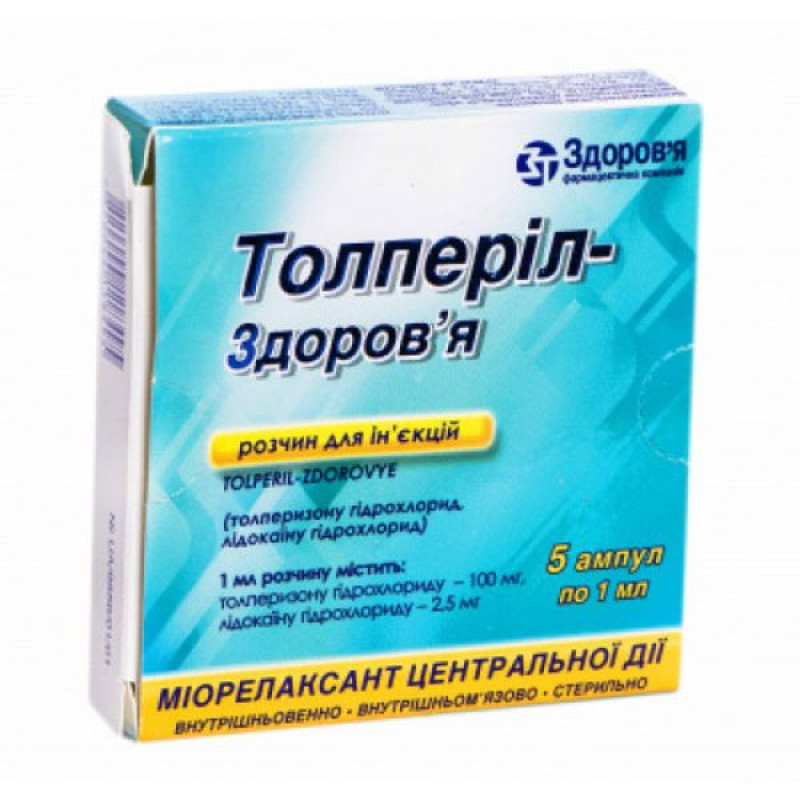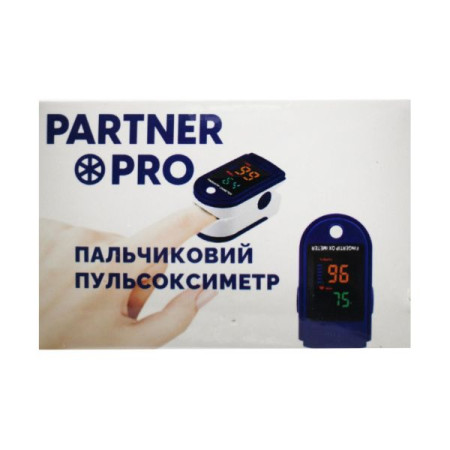Tolperil-Zdorovye solution for injection ampoule 1 ml in blister No. 5

Instructions Tolperil-Zdorovye solution for injection ampoule 1 ml in blister No. 5
Composition
active ingredients: tolperisone, lidocaine;
1 ml of solution contains tolperisone hydrochloride 100 mg, lidocaine hydrochloride 2.5 mg;
Excipients: diethylene glycol monoethyl ether, methylparaben (E 218), water for injections.
Dosage form
Solution for injection.
Main physicochemical properties: clear, colorless or slightly colored solution.
Pharmacotherapeutic group
Centrally acting muscle relaxants. ATC code M03B X04.
Pharmacological properties
Pharmacodynamics
Centrally acting muscle relaxant. The mechanism of action is due to inhibition of impulse conduction of primary afferent fibers and motor neurons as a result of membrane-stabilizing and local anesthetic action, which leads to blocking of spinal mono- and polysynaptic reflexes. By inhibiting the influx of Ca2+ into the synapse, it secondarily prevents the release of mediators. Inhibits the conduction of excitation along the reticulospinal pathway. Increases peripheral blood flow regardless of the influence of the CNS. The weak antispasmodic and antiadrenergic effect of tolperisone may play a role in the development of this effect.
Pharmacokinetics
Bioavailability due to extensive metabolism is about 20%. Metabolized in the liver and kidneys. The pharmacological activity of metabolites is unknown. T½ after intravenous administration is approximately 1.5 hours. Excreted by the kidneys, more than 99% in the form of metabolites.
Indication
Muscle spasticity, including post-stroke spasticity, in cases where the injectable form is the form of choice.
Contraindication
Hypersensitivity to the components of the drug/amide local anesthetics, eperisone. Myasthenia gravis.
Interaction with other medicinal products and other types of interactions
Concomitant administration of tolperisone increases blood concentrations of drugs that are primarily metabolized by CYP2D6, including thioridazine, tolterodine, venlafaxine, atomoxetine, desipramine, dextromethorphan, metoprolol, nebivolol, perphenazine. No significant inhibition or induction of other CYP isoenzymes (2B6, 2C8, 2C9, 2C19, 1A2, 3A4) was detected.
It is expected that co-administration with other CYP2D6 substrates and/or other drugs will not increase exposure to tolperisone, due to the diversity of tolperisone metabolic pathways.
Tolperisone enhances the effect of niflumic acid, so with simultaneous use, a dose reduction of the latter may be required, as with other NSAIDs.
Although tolperisone is a centrally acting drug, the likelihood of developing a sedative effect when using it is low. In the case of simultaneous administration with other centrally acting muscle relaxants, it is necessary to consider reducing the dose of tolperisone.
Application features
The drug should not be prescribed to children.
Hypersensitivity reactions have been most commonly reported with tolperisone. Their severity ranges from mild skin reactions to severe systemic reactions, including anaphylactic shock. Symptoms of hypersensitivity reactions may include erythema, rash, urticaria, pruritus, angioedema, tachycardia, hypotension or dyspnoea.
Women with a history of hypersensitivity to other drugs or allergic conditions are at higher risk of hypersensitivity reactions when using tolperisone.
Patients should be advised to be aware of the possibility of allergy. Patients should be informed that if symptoms of allergy occur, they should stop taking tolperisone and seek medical attention immediately.
After an episode of hypersensitivity to tolperisone, the drug should not be re-administered.
The drug contains lidocaine, therefore, in case of known hypersensitivity to lidocaine and other amide local anesthetics, the drug should not be used due to the possibility of developing cross-allergic reactions.
Use during pregnancy or breastfeeding
There is evidence that tolperisone does not have a teratogenic effect in animals. The use of the drug in the I trimester of pregnancy is contraindicated. The use of the drug in the II and III trimesters of pregnancy is possible when, in the opinion of the doctor, the expected benefit significantly outweighs the potential risk to the fetus/child.
Since it is not known whether tolperisone passes into breast milk, the use of the drug during breastfeeding is contraindicated.
Ability to influence reaction speed when driving vehicles or other mechanisms
Given the possibility of dizziness, drowsiness, impaired attention, epilepsy, blurred vision, the drug should be used with caution when driving vehicles and other mechanisms.
Method of administration and doses
For parenteral administration to adults only: the drug is administered intramuscularly at 1 ml 2 times a day or slowly intravenously at 1 ml 1 time a day. The duration of treatment is determined by the doctor depending on the nature of the disease and the effectiveness of the treatment.
Children
Do not use the injection solution in children.
Overdose
Data on overdose are limited. The drug has a wide therapeutic index, with data showing that a dose of 600 mg administered orally to children did not cause symptoms of overdose. Irritability was observed when 300-600 mg/day was administered orally to children. There is evidence that administration of high doses has caused ataxia, tonic-clonic convulsions, difficulty and respiratory arrest.
Treatment: drug withdrawal, symptomatic and supportive therapy. There is no specific antidote.
Adverse reactions
Approximately 50-60% of adverse reactions associated with the use of tolperisone were hypersensitivity reactions. In general, these reactions were mild and self-limiting. Life-threatening hypersensitivity reactions have occurred in isolated cases.
From the blood and lymphatic system: anemia, lymphadenopathy.
Immune system disorders: hypersensitivity reaction, anaphylactic reaction, anaphylactic shock.
Mental disorders: insomnia, sleep disorders, decreased activity, depression, confusion.
From the nervous system: headache, dizziness, drowsiness, impaired attention, tremor, convulsions, hypoesthesia, paresthesia, lethargy.
From the sensory organs: visual impairment, tinnitus, vertigo.
From the vascular system: hypotension, skin hyperemia.
Cardiac: angina pectoris, tachycardia, palpitations, decreased blood pressure, bradycardia.
Respiratory system: difficulty breathing, nosebleeds, shortness of breath.
On the part of the digestive system: nausea, vomiting, abdominal discomfort, diarrhea, dry mouth, dyspepsia, epigastric pain, constipation, flatulence, mild liver damage.
Skin: allergic dermatitis, hyperhidrosis, itching, urticaria, rashes.
Musculoskeletal system: muscle weakness, myalgia, discomfort/pain in extremities, osteopenia.
From the urinary system: enuresis, proteinuria.
General disorders: asthenia, discomfort, fatigue, anorexia, feeling of intoxication, feeling of heat, irritability, thirst, polydipsia, feeling of discomfort in the chest, changes at the site of drug administration (including redness).
Laboratory parameters: increased bilirubin concentration in the blood, changes in liver enzyme activity, decreased platelet count, leukocytosis, increased creatinine concentration in the blood.
Expiration date
3 years.
Storage conditions
Store in original packaging at a temperature of 2°C to 8°C. Keep out of the reach of children.
Incompatibility
Data are lacking, therefore the drug should not be mixed with other drugs in the same syringe. Administer separately from other drugs.
Packaging
Solution for injection in 1 ml ampoules No. 5 in a box; No. 5 or No. 5x2 in a blister, in a box.
Vacation category
According to the recipe.
Producer
LLC "Pharmaceutical Company "Zdorovya".
Location
Ukraine, 61013, Kharkiv, Shevchenko St., 22.
There are no reviews for this product.
There are no reviews for this product, be the first to leave your review.
No questions about this product, be the first and ask your question.



